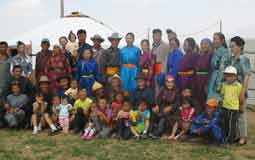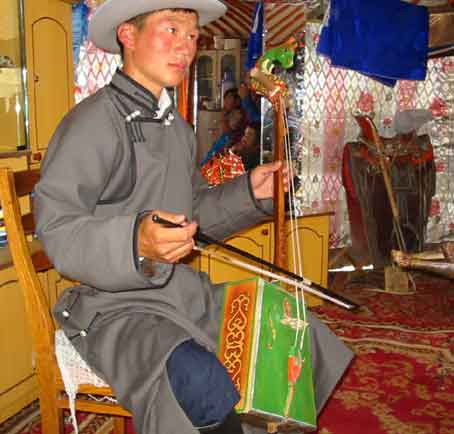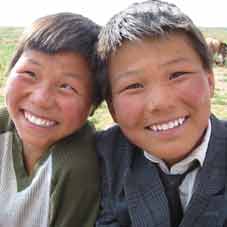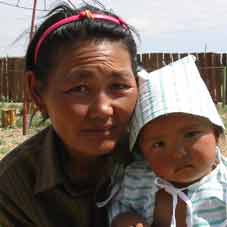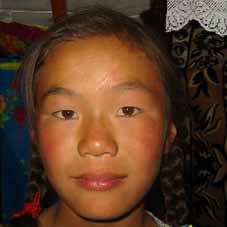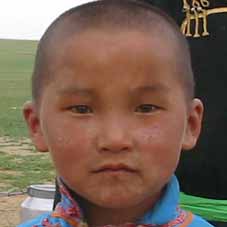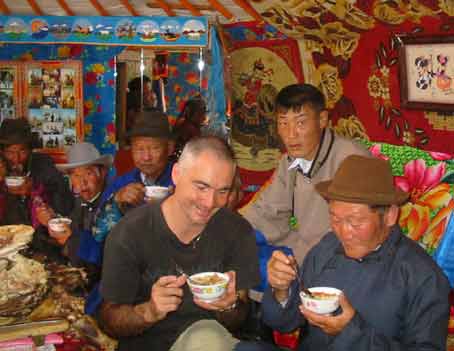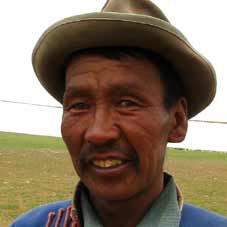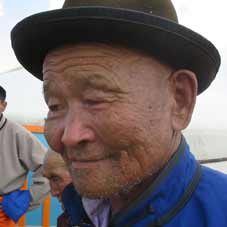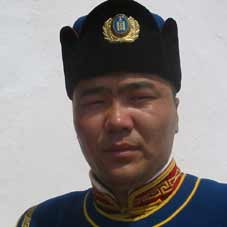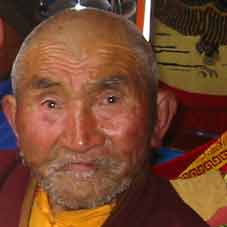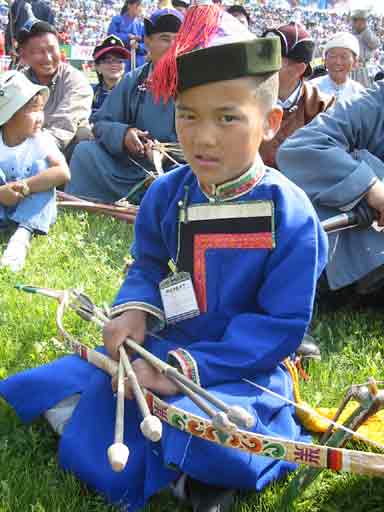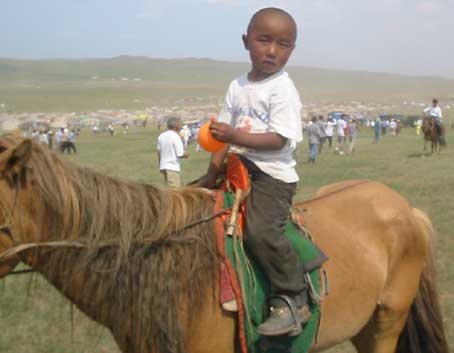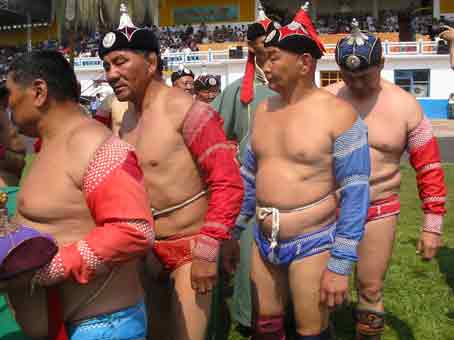A "steppe"
in the right direction!
I
want to say thank you to all the people that emailed me for their encouragements
and well wishers.
The first thing I wanted to find out while in Ulan Ude was the possibility of
getting a new rear suspension so I emailed David Killeen from Southbank
motorcycles in Melbourne. I was told that BMW Australia did not have any in
stock and that they would have to chase one from around the country or from
Germany and that it would take a few days. I arranged with David to send me
one to Ulaanbaatar in Mongolia as soon as he could.
I took advantage of some free time to give my bike a good service, oil and filter
change as well as checking everything else. Anywhere else would have been easy
but that day I had a drunken old man that kept on touching everything and making
a nuisance of himself as only drunks can do.
I decided, against David recommendation, to try to ride to Ulaanbaatar, the
capital of Mongolia, some 600km south of Ulan Ude. I left very early as I wanted
to do the trip in one day; I knew that I had to ride much slower than usual
and that I would at least lose one or two hours at the border. Crossing the
border went very well but still took a couple of hours.
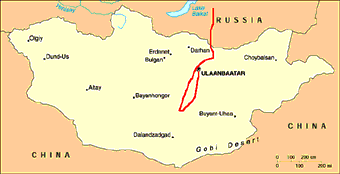
Mongolia
was not on my itinerary mostly because I did not think that I could enter it
easily but when World Vision Australia told me that there were projects
there I decided to make the detour.
Mongolia is a landlocked country almost as big as
the
Australian state of Queensland. The southern third of Mongolia is dominated
by the Gobi Desert, which stretches into China. The rest is desert steppe and
has sufficient grass to support scattered herds of sheep, goats and camels.
With over 260 days of sunshine a year, Mongolia is justifiably known as the
"land of Blue Sky", nevertheless it has an extreme continental climate,
meaning that it is so far inland that no sea moderates its climate. The winter
is very harsh and long with temperature as low as -50 degrees, humidity is zilch
and sunshine intense.
Mongolia has a population of a little more than 2 million people (700 thousand
of them live in Ulaanbaatar) but there are more Mongolians living outside of
Mongolia, three and half million in China and nearly one million in Russia.
Sunday 29 June 2003.
I arrived in Ulaanbaatar at around 5 pm and was spotted by Zina Deretsky while
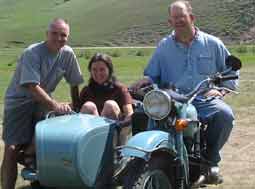
trying
to work out where to go to find a place to stay. It turned out that Zina and
her husband Alan (pictured), from the USA, had been living in UB (short for
Ulaanbaatar) for a year after winning a Luce Scholarship. Zina is actually a
medical and scientific illustrators and Alan is a computer art designer. As
they both ride motorcycles they were very interested in my stories and they
invited me to stay at their place for as long as I
wanted.
Thank you so much guys for your hospitality and who knows we might meet again
in the States.
I did not want to impose on them so a couple of days later I found a cheap guesthouse
in the centre of town and for only US$4 I had a bed in a dorm sharing with 5
other travellers.
The next few days were spent at visiting the city, meeting with the staff at
World Vision Mongolia national office and spending time with friends of Zina
and Alan.
Monday 7 July.
I received an email from David Killeen who told me that they had find a company
in Germany who could send me a new suspension for around 870 US dollars, having
no alternative I agreed and was told than I should get it in about 4 days.
We shall see!
I had organized with World Vision to go and visit the Dundgobi aimag
project, some 300km south of UB on unsealed roads.
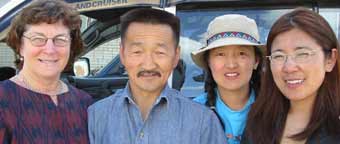
I
was joined by Sue Bryan (a volunteer from New Zeland), Mijigee the driver (also
known as Mister President), Byambatseren Adiya the National Co-ordinator for
Customer Relations Service (the
comedienne
of the lot) and Tuvshinjargal Perenlei the Dundbobi ADP Team Leader (pictured).
We left UB at around 11am and arrived at Mandelgobi, a small town, no
sooner than 5pm. The emptiness of the land with no fences and no privately owned
land is awesome and at times it felt like I could see the curvature of the earth.
World Vision Australia does not yet have an area development project in Mongolia
but I am told that it will happen very soon. The Dundgobi project is supported
by World Vision Taiwan.
From 1999 to 2000 many areas of Mongolia have suffered from the effects of the
dzud, a natural disaster which comes in the form of summer droughts followed
by very cold winters and heavy snowfalls. These disasters have caused the deaths
of over 8 million livestock throughout Mongolia, affecting the livelihoods of
thousands of herding families who depend on their animals for their very survival.
World Vision Mongolia responded to these series of disasters, distributing emergency
relief food rations to stricken families and providing fodder and hay for their
dying animals. World Vision moved from relief to rehabilitation projects in
the Dundgobi province in 2000. Three hundred and fifty families (almost 2,000
beneficiaries) participated in the first relief food security project which
concentrated on teaching vegetable gardening skills. ADP's are involved
in facilitating various programs according to the needs and priorities of the
community and when combined with Child Sponsorship programs focus on helping
the family to improve the development which includes health, nutrition, education,
gardening and agriculture, water sanitation, leadership training, advocacy and
child rights, skills training and income generation.
We started our visit with the gardening project which has been operating for
two years. The project has included 6,700 beneficiaries from 8 districts who
were without income. With guidance and help from WV several households have
formed themselves into co-operatives making a contract with the Dundgobi ADP.
Batbold, the initiator and leader of the gardening cooperative told me that
their cooperative has 14 households as members and have use of 1.4 square hectares
of agricultural land. Each month every member receives an income of $US15.00
from their profits.
Most of the country people lives from the products of their herds so it was
good to see that there are other ways of surviving introduced in their lives.
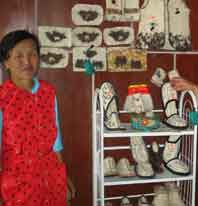
Other
skills training courses which teaching sewing, tailoring, wool crafts (pictured),
and felt making have provided income generating skills which have enabled other
cooperatives to establish themselves.
One of the big problems in Dundgobi province is the number of children who live
in difficult circumstances and women headed families. Ten thousand dollars have
been donated to buy 22 gers, for homeless families in 5 districts. A ger
is a traditional Mongolian round felt covered dwelling originally used by nomadic
herders. For around $US550.00 you can
donate
a ger through the "gift a ger project". Bat-Ochir is a beneficiary
from World Vision's "gift a ger project" and she said to me
"For many years we have wandered around because we had no permanent home.
Now WV has provided us with a ger, our own home. I will always be grateful to
the organization. I did not have any work, receiving a pension of $US12.00 a
month but, now I have learned to sew bed covers which I sell for $US18.00. I
have 5 children, 2 of which are involved in the child project".
One of the most important community projects is to improve the nutrition of
children form 6 months to 3 years old. Dundgobi ADP has established programs
called "summer strengthening", "winter supplementary feeding"
and "Milk centre for children". In total the health of over 700 children
in the WV Nutrition project is being improved.
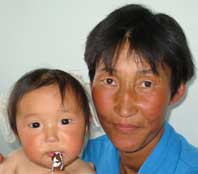
One
mother (pictured) said to me "our child was malnourished but now he is
becoming healthy". Mothers learn from this project how to give nutritious
food to their babies and how to stay healthy.
As you can see World Vision is working very hard at changing children's lives
and bringing hope for the future.
On the second day of my visit I was taken to a traditional herder's family.
I was able to experience the way they live and what they eat. First, they served
us
some hot salty tea, then some warm, fresh yogurt, a bowl of vodka, and a kind
of soup made with dry meat (borts), vegetables and pasta. I was delighted to
learn that I did not have to finish every single bowl placed in front of me.
We were also offered some dairy snacks, one of it was a dried milk curds, which
was very hard and not very tasty, another one was a very sharp soft fermented
cheese called aarts. While we were eating they prepared the Khorkhog,
which is made by placing hot stones from the fire into a pot with chopped sheep,
some water and sometimes vodka and then sealing the pot and putting it on the
fire. When eating Khorkhog it is customary to pass the hot greasy rocks from
hand to hand, as this is thought to be good for your health. After lunch I was
offered to ride a horse which I did but did not manage to make him do anything
else than walk while all the kids were racing passes me on their galloping horse.
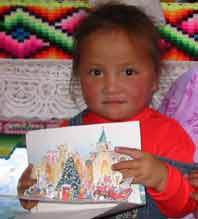
On
my last visit for the day I was lucky enough to meet a sponsor child (pictured)
who was so happy to show me a card that she had received from her sponsor's
parents. World Vision Mongolia encouraged sponsors to send gifts to their sponsor's
child, one other little girl show me her doll and a blanket that she was treasuring.
On the other hand some WV offices do not encourage such gifts, so ask your local
office before sending anything.
If you would liked to sponsor a child from Mongolia or any other country just
click here to find out more about child sponsorship.
On
our returned trip to UB, Mister President (our friendly and skilful driver)
took a different route in order to show us Baga-Gazriin chuluu, which
is a rocky mountain 1,768 meters above sea level. Along the way I asked him
to stop so that I could take a photo of a couple of gers (traditional Mongolian
home) and set in the middle of nowhere. Soon the owner of one of the ger came
out and invited us into his home. It was a very special day for him as he was
marrying his son and his daughter. Again we went through the salty tea, the
not so good cheeses, some food, and the bowl full of vodka. One other thing
I had the pleasure to experience was the Airag, a fermented mare's milk,
with an alcohol content of about 3 %. I was told that airag will be good for
my health as it is a milk product. I agreed knowing very well that wine is good
for me as well because it's made from grapes! As for the taste it reminded me
very much of some very old cider left in an old barrel but with a different
colour. The whole family was thrilled to have such special guests on such a
special day and I was delighted to have the chance of experiencing a traditional
Mongolian wedding.
Driving through the country is not easy as there is no road, even for an expert
driver like Mister President. Most of the time he had no idea where we were
and kept on asking the local herders which way was UB. We finally arrived back
in UB at around 7.30 pm. I want to take this opportunity to thank World Vision
Mongolia and my travel companions for giving me the chance to learn so much
about Mongolia and its people.
Friday 11 July.
That was the first day of the Naadam festival. This is the biggest
event of the year in the Mongolia calendar and goes on for three days. It
is like a nomad Olympics with wrestling, horse racing and archery been the
main sports. Naadam has its roots in the nomad assemblies and hunting extravaganzas
of the Mongol armies.
My very good friend Byamba from WV was my guide for the event. First
we went to the opening ceremony in the Naadam stadium which included an impressive
march of monks and athletes, plenty of music, a speech from the real President,
some acrobats doing tricks on horses and parachute displays. Then the wrestling
started. Mongolian wrestling is similar to wrestling found elsewhere, except
there are no weight divisions, so the biggest wrestlers are often the best.
There is also no time limit and the bout will continue with short breaks.
It will end only when the first wrestler falls, or when anything other than
the soles of the feet or open palms touch the ground. They wear heavy boots
and a tight, unflattering pant, more like a brief pair of underwear. They
also wear an open-fronted vest which was allegedly introduced after one Amazonian-sized
female wrestler floored all the male wrestlers. When it was discovered that
she was a woman the vest was introduced to ensure that women would no longer
take part in bouts.
Then we went to the horse racing some 40km from UB. There are six categories
of horse racing, depending on the age of horses, a young horse will race for
15km while the six or seven year old horses will race up to 30km. There can
be up to 1000 horses per race. There are no tracks or courses; it is just
open countryside, which leaves great scope for cheating. Jockeys, boys and
girls between five and 13 years old, prepare for months for special races,
particularly at Naadam.
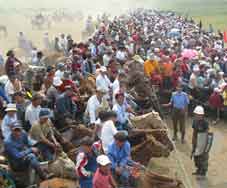
The
place was very dusty and crowded (pictured).
The next day I went back to the stadium to see the archery. Archers use a bent
composite bow made of layered horn, bark and wood. Usually, arrows are made
from willows and the feathers are from vultures and other birds of prey. The
archers are traditionally dressed and the men stand 75 meters from the target
and the women 60 meters.
In the evening Byamba took me to a concert held at the State Opera and Ballet
Theatre. It was a stirring
ballet
of traditional Mongolian dances and music.
Well, my suspension has not arrived yet and my two weeks visa is up. I will
have to extend my visa and hope for the best. At the moment my bike is safely
parked in a garage but how long will I have to wait?
Mongolia has been such a breath of fresh air after Russia and Siberia, its people
are so friendly and the countryside so interesting that I don't really mind
been stuck here for a while.
Bayartai. Click here for more
photos
Après la pluie le beau temps!
Je
veux d'abord remercier tous les gens qui m'ont envoyés des Emails d'encouragement
et de soutient, c'est bon pour le moral comme dit la chanson.
La première chose que je devais faire en arrivant à Ulan Ude
c'était de voir comment je pourrai recevoir un amortisseur. J'ai donc
toute suite envoyée un email à David Killeen, le concessionnaire
qui m'a vendu la moto à Melbourne, en lui expliquant le problème.
Il me répondait en me disant que BMW Australie n'en avait pas en stock
mais qu'il allait essayer de m'en faire envoyer un directement d'Allemagne.
Je lui répondais de l'envoyer directement à Ulaanbaatar,
la capitale de la Mongolie.
Ayant quelques jours de libre j'en profitais pour changer l'huile et les filtres
de ma moto. Chose facile habituellement mais rendu plus difficile à cause
d'un clochard soûl qui touchait à tout et trébuchait sur
les pièces autour de la moto. Impossible de m'en débarrasser.
Je décidais de reprendre la route quelques jours plus tard en espérant
pouvoir gagner Ulaanbaatar contrairement à toutes recommandations de
BMW. Je partais à 7 heures du matin sachant que j'avais 600km à
faire en allant beaucoup moins vite que d'habitude et aussi une frontière
à passer. Le passage de la frontière ne posa aucun problème
mais je perdais quand même 2 heures.
Je n'avais pas vraiment prévu passer par la Mongolie. Quand j'avais étudié
mon itinéraire la Mongolie me semblait presque inaccessible, croyant
que je ne pourrais jamais avoir un visa ou que je n'aurai pas le droit d'entrer
avec ma moto comme c'est le cas avec la Chine. Mais quand World Vision m'ont
informé qu'il y avait des projets en Mongolie je n'ai pas hésité
à me renseigner sur les possibilités d'y aller.
La Mongolie est entouré par la Russie et la chine et elle fait
presque trois fois la grandeur de la France. Au sud on y trouve le grand désert
du Gobi qui s'étend jusqu'en Chine, le reste du pays est un désert
de steppe, suffisant à nourrir les troupeaux de chèvres, vaches,
moutons et chameaux parsemés dans cette région. Avec ces 260 jours
ensoleillés par an, la Mongolie est surnommée 'le pays au ciel
bleu', néanmoins c'est aussi un pays avec des climats extrême car
il est tellement à l'intérieur des terres qu'il n'y a pas de mer
pour modérer son climat. Les hivers sont très dur et très
long avec des températures qui descendent jusqu'à moins 50 degrés,
sans aucune humidité. L'été ne dur que trois mois, c'est
à cette époque qu'il pleut un peu mais la température reste
au environ de 25 degrés.
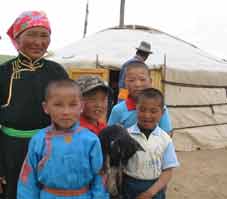
La
population de la Mongolie est d'un peu plus de 2 millions seulement (700 milles
habitent la capitale) mais il y a plus de Mongols à l'extérieur
de la Mongolie qu'à l'intérieur, 3 millions habitent la Chine
et 1 million la Russie. Les Mongols sont des nomades et ils vivent que des produits
de leurs animaux, lait, viande et fromages. Ils vivent dans des Gers (photo),
genre de tente en toile ronde avec un feu au milieu. Ils se déplacent
environ trois fois par an, à la recherche d'herbes pour leurs troupeaux.
Dimanche 29 Juin 2003.
J'arrivais à Ulaanbaatar vers 17 heures, ne sachant pas trop où
aller je m'arrêtais pour consulter mon guide de voyage quand Zina m'a
remarqué. Zina et son mari Alan sont Américain et vivent à
UB (Ulaanbaatar) depuis un an. Comme tout les deux aiment la moto ils étaient
très intéressé par mon histoire et me proposaient de venir
chez eux pour une semaine (date de leur retour au USA). J'en profite pour les
remercier et qui sait peut être vais-je les rencontrer de nouveau aux
Etats-Unis.
Comme je ne voulais pas abuser de leur hospitalité je trouvais une petite
pension dans le centre ville pour juste 4 euros avec une chambre commune. Du
fait de la maladie Sars (virus venu de chine) il n'y a guère de touristes
en Mongolie donc la pension est plus ou moins vide.
Je passais les jours suivant à visiter la ville avec mes amis Américain,
et aussi à organiser la visite de projet avec le personnelle de World
Vision.
Lundi 7 Juin.
Ce matin là je recevais un email de BMW qui me disait que l'amortisseur
allait me coûter 870 euros et que je devrais le recevoir d'ici 4 jours,
n'ayant pas le choix j'acceptais.
J'avais aussi organisé avec WV d'aller visiter le Dundgobi Aimag projet
à 300km au sud de UB sur une route non goudronné.
J'étais accompagné de Sue Bryand (volontaire de Nouvelle Zélande),
Byambatseren (en charge des relations publique), Tuvshenjargal (responsable
du projet) et de Mjigee (notre chauffeur).
Après 6 heures de route on arrivait finalement dans la petite ville
de Mandelgobi. World Vision France n'ont pas de projet en Mongolie,
n'y d'ailleurs l'Australie. Le projet de Dundgobi est financé par WV
Taiwan.
De 1999 à 2002 beaucoup d'endroits en Mongolie ont souffert des effets
du dzud (un désastre naturel qui occurrent après des étés
sans pluie suivi d'hivers très froid avec beaucoup de neige). Ces catastrophes
ont causés la mort de plus de 8 millions de bétails à
travers la Mongolie rendant la vie de milliers de familles Mongols invivable.
N'ayant plus assez d'animaux pour survivre beaucoup de famille ont quittés
les terres et sont venus prendre refuge dans les villes. WV est d'abord intervenu
en apportant des vivres à ces gens là mais maintenant ils se
concentrent à créer des emplois de façon que les familles
puissent apprendre à survivre par d'autres moyens. L'intervention de
WV consiste maintenant à développer l'agriculture, l'éducation,
la nutrition, la santé et les problèmes sanitaire.
Nous avons d'abord visité des projets de jardinage ou avec la guidance
de WV les gens apprennent à cultiver. WV ont aussi crée des
endroits ou les gens apprennent à coudre et à fabriquer des
objets qui peuvent être vendu aux touristes. Tout ça leur apportent
de quoi survivre et leur donne aussi une raison de vivre. Une femme me raconta
qu'elle était arrivés dans cette ville avec plus rien du tout
mais que grâce à WV elle habitait maintenant dans une ger et
avait appris à fabriquer des couvres lits qu'elle vendait au marché
ce qui lui permettait de nourrir sa famille. Il y a beaucoup de cas comme
ça ou l'on peut vraiment apprécier la différence qu'apporte
WV à tous ces gens.
Un autre projet très important c'est celui de la nutrition des enfants
de bas ages. En effet beaucoup d'enfants sont mal nourris donc WV ont établis
des programmes de formation sur la nutrition pour les mamans. Celles-ci viennent
passer quelques semaines dans ces centres et apprendre à nourrir proprement
leurs enfants. On peut vraiment constater que WV travaillent très dur
à changer la vie des enfants et a leur apporter de l'espoir pour le
futur.
Un après midi j'ai eu la chance de pouvoir visiter une famille de nomade,
d'apprendre leur façon de vivre et de quoi ils vivent.
En arrivant ils me servaient du yaourt encore tout chaud, puis un bol de thé
salé avec du lait. Ensuite j'avais le droit à un bol de vodka
et à une soupe faite de viande séché, légumes
et de pâte. J'étais très content d'apprendre que je n'étais
pas forcé de tout finir. On m'offrait aussi des fromages, fait maison
bien. Pendant ce temps, dehors ils préparaient le Khorkhog, un plat
qui consiste à placer des cailloux très chaud dans un pot avec
des morceaux de mouton, de l'eau et quelques herbes. On remets le tout sur
le feu pendant une heure, et voila ! La tradition veut que l'on se passe un
caillou bien gras et bien chaud de main à main, apparemment c'est bon
pour la santé. Un peu comme la bénédiction papal, ça
ne fait pas de bien et ça ne fait pas trop de mal.
Après le repas on me faisait monter à cheval. Alors que tous
les gosses galopaient autour de moi sur leurs montures le mien ne voulait
rien savoir et marchait tout doucement, heureux de m'embarrasser devant mon
public.

Le
dernier jour de ma visite on me présentait une petite fille (photo) qui
était parrainée, elle était si contente de me faire voir
une carte qu'elle venait de recevoir de ces parrains ainsi qu'une poupée
et une couverture. En général WV n'encourage pas les parrains
d'envoyer de gros cadeaux aux enfants mais ce n'est pas le cas en Mongolie.
Si vous tenez à envoyer un cadeau renseignez vous d'abord auprès
de votre WV.
Si vous aimeriez parrainer un enfant en Mongolie ou d'un autre pays cliquez
ici pour en savoir plus.
Pour notre retour, notre chauffeur tenait à nous faire visiter le pays
et prenais une route différente à travers la steppe. Il
voulait
nous faire découvrir Baga-Gazriin chuluu, une montagne rocheuse
à 1,768 mètres au-dessus du niveau de la mer. En chemin je lui
demandais de s'arrêter car j'avais remarqué 4 gers et je voulais
les prendre en photo. Quelques minutes plus tard nous nous retrouvions inviter
à un mariage Mongolien. En effet, le chef de cette famille était
venu me trouver et me disait qu'il serait très heureux que l'on vienne
chez lui. Il mariait (photo) ce jour là son fils et sa
fille.
Encore une fois j'avais le droit au thé salé, au fromage, a la
vodka et a de la soupe. On m'offrait aussi un bol de Airag, un lait fermenté
de jument qui contient environ 3% d'alcool. Cela me faisait penser un peu à
un vieux cidre qui serait resté dans un fût un peu trop longtemps
mais bien sur d'une couleur différente, l'airag est blanc. On me disait
aussi que l'airag était très bon pour la santé car cela
est fait à base de lait, j'étais tout à fait
d'accord
sachant que le pinard est aussi bon pour ma santé car il est fait avec
du raisin. Quelle expérience!
Conduire dans ce pays n'est pas une chose facile car il n'y a aucune route juste
quelques sentiers qui vont un peu partout à travers la steppe, même
notre chauffeur avait du mal à si retrouver et devait demander quelle
direction prendre aux nomades.
Nous arrivions à bon port vers 20 heures et je tiens à remercier
toute l'équipe de WV de m'avoir donner l'occasion de découvrir
ce pays et surtout tous ces gens formidable.
Vendredi 11 Juin.
C'était le premier jour du festival Naadam. C'est le plus grand
festival Mongol de l'année et dur 3 jours. C'est un peu leurs jeux
olympiques mais il n'y a que trois sports principaux, la lutte, les courses
de chevaux et le tir à l'arc. Naadam est un restant du temps des nomades
et des armées Mongols ou la guerre était leur passe temps favoris.
Mon amie Byamba de WV était mon guide pendant les trois jours que durait
le festival. Nous sommes d'abord aller à la cérémonie
d'ouverture dans le stadium. Un défilé extravagant de Monk et
d'athlètes a ouvert la parade accompagné de musique, puis le
président Mongol a fait son discourt. Ayant ma carte de presse sur
moi je pouvais suivre le tout au premier rang avec les photographes et la
télévision. Des acrobates sur chevaux et une exhibition de parachutiste
terminèrent la présentation.
Puis les jeux ont commencé avec les lutteurs. La lutte en Mongolie
est comme partout avec la seule différence qu'il n'y a pas de division
par poids. Ce qui veut dire qu'un costaud de 150kg peut affronter un maigrichon
de 60kg, en général c'est le gros qui gagne. Il n'y a pas de
limite de temps, donc des fois cela peut durer très longtemps, voir
quelques heures, les lutteurs tournent en rond en se tenant par la taille.
Le match est gagné quand un des lutteurs tombe parterre ou qu'une part
de son corps touche le sol, à part la sol de ces pieds ou la palme
de sa main. Ils sont vêtus des grosses bottes (voir photo dans la galerie
photo), d'un petit maillot de bain et d'une veste ouverte sur le devant. La
raison pour laquelle la veste est ouverte devant c'est qu'une fois une femme
avait participé au jeu et avait le concours, embarrassant tout les
hommes. Donc depuis ils portent cette veste ridicule pour montrer qu'ils n'ont
pas de seins à cacher.
Ensuite nous sommes allés voir les courses de chevaux, à 40
Km de UB et en pleine campagne. Il y a 6 catégories de courses de chevaux,
suivant l'age du cheval. Les plus jeunes court seulement 10 Km et les plus
vieux jusqu'à 35Km. Il n'y a pas de piste ou de circuit, ils partent
d'un point et doivent en gagner en autre en passant par ou ils veulent, donc
des fois il y a de la triche. Les jockeys sont des garçons et des filles
âgés entre 5 et 13 ans. IL y a jusqu'à 1000 participants
par course et ils s'entraînent pendant des mois avant la grande course.
Le jour suivant je suis retourné au stadium pour voir le tir à
l'arc. Les tireurs sont tous habillés traditionnellement et la cible
se trouve à 75 mètres pour les hommes et à 60 mètres
pour les femmes.
Dans la soirée Byamba m'emmena voir un concert à l'opéra.
C'était un ballet de l'histoire Mongols avec musique, chants et danses.
Les costumes étaient fantastique, vraiment une représentation
unique que je ne suis pas prêt d'oublier.
Cela fait maintenant deux semaines que je suis ici et je n'ai toujours pas
reçu mon fameux amortisseur. J'ai déjà du demander une
extension de mon visa (30 euros pour 14 jours) et je crois qu'il ne me sera
pas permis de le rallonger une deuxième fois.
Ma moto est dans un garage, en toute sécurité mais impatiente
de reprendre la route.
Mongolie a été une surprise pour moi et a sauté tout
en haut de ma liste de pays favoris, quand à la Russie elle est largement
en tête tout en bas de cette liste.
Il va y avoir une deuxième partie sur la Mongolie, ne la ratez pas
si vous voulez savoir dans quelle direction vais-je poursuivre ma route et
comment!
Bayartai à tous.
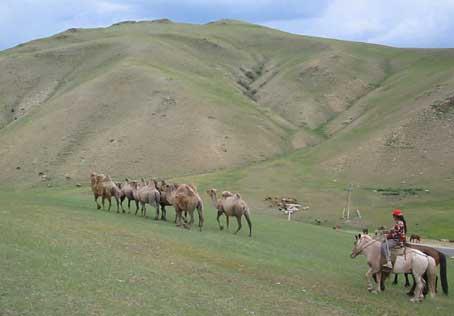
Young girl with her herd
of camels.
Jeune fille avec son troupeau de chameaux.
Traditional music instrument.
Traditionel instrument de musique.
Faces of Mongolian's children.
Visages d'enfants de Mongolie.
Lunch time in a ger.
L'heure du casse croûte.
Woman picking up cow dung
for the fire.
Une femme ramassant les grottes pour faire du feu.
Mongolian men.
Visages d'hommes.
Archer at the Naadam festival.
Tireur à l'arc au festival de Naadam.
A young archer waiting for
his turn.
Jeune tireur à l'arc attendant son tour.
Children learn how to ride
from the age of two.
Les enfants apprennent à montée à cheval dès 2
ans.
Wrestlers getting ready.
Lutteurs dans leurs costumes.
 |
 |
 |
 |
 |
 |
 |
 |
 |
 |
 |
 |
 |
|
JOURNAL 21.
14/07/03 . Mongolia . Total
mileage so far 44,550km .
(Pour la version française
du journal, allez au bas de la page ou cliquez
içi.
Pour revenir à la version française du site, cliquez
sur Français)
How
can you help make Ride4Kids a worthwhile project? To find out,
click here.
|
|










